The Weizenbaum Institute conducts research in a variety of ways. To provide an insight into the different research practices, from now on the Methods Lab will be presenting selected projects in longer features. For the first text in this series, Anna Hohwü-Christensen visited the Berlin Open Lab (BOL) to meet Ines Weigand and Corinna Canali from the research group Design, Diversity and New Commons.
I first met Ines and Corinna at the BOL in June, where they led the workshop Flushed Away: A Workshop on Disgust, Gender, and the Technical Object as part of the DGTF’s (Deutsche Gesellschaft für Design-Theorie und -Forschung) Design and Digital Justice Conference. Ines and Corinna are research associates affiliated with the Weizenbaum Institute through the research group Design, Diversity and New Commons. A group that, in turn, forms a cornerstone in the Design Research Lab initiative—a network of researchers and organizations that aim to bridge the gap between technological innovations and people’s real needs.
BOL is a dynamic and experimental space that brings together experts from design, engineering, the humanities, and maker communities. Based at the University of Arts Berlin (UdK) in Berlin-Charlottenburg, it acts as a convergence point for four institutions: Weizenbaum Institute, UdK, Technical University, and the Einstein Center Digital Future. Home to numerous transdisciplinary research projects, events, and conferences, BOL operates with the mission of application-oriented and inclusive design of human-technology interaction, and transparent, participatory research.
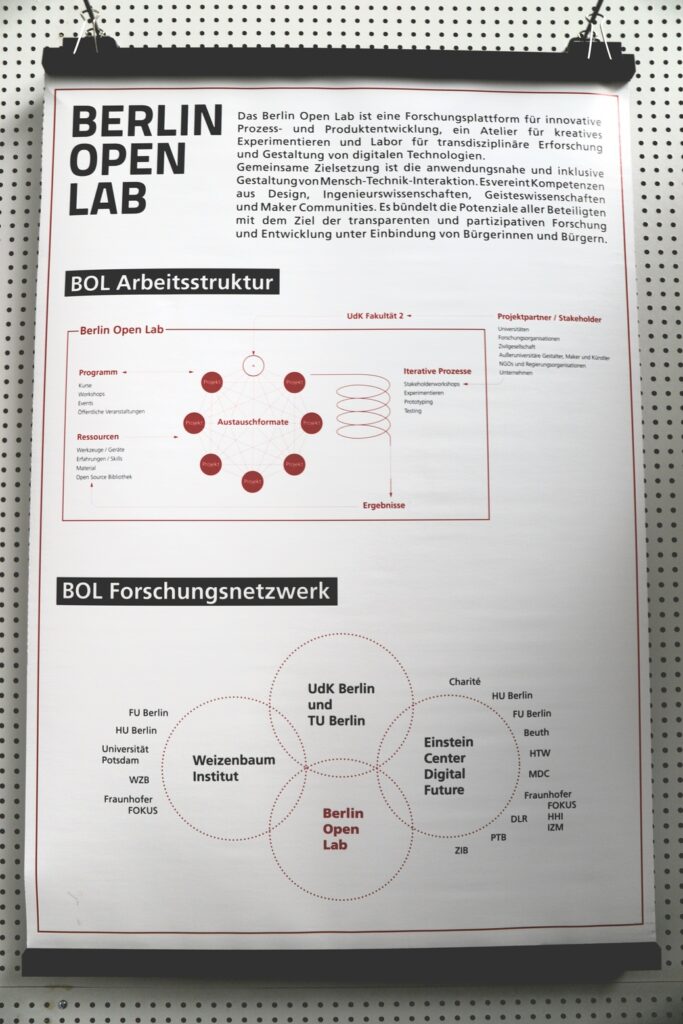
Following my initial visit, I decided to find out more about the lab and the part played by the Weizenbaum Institute within its intricate framework. During a comprehensive tour, I got to chat with Ines and Corinna not only about the space and its many diverse projects, but also about research and interdisciplinarity in design practices, and the importance of critical thinking in material making.
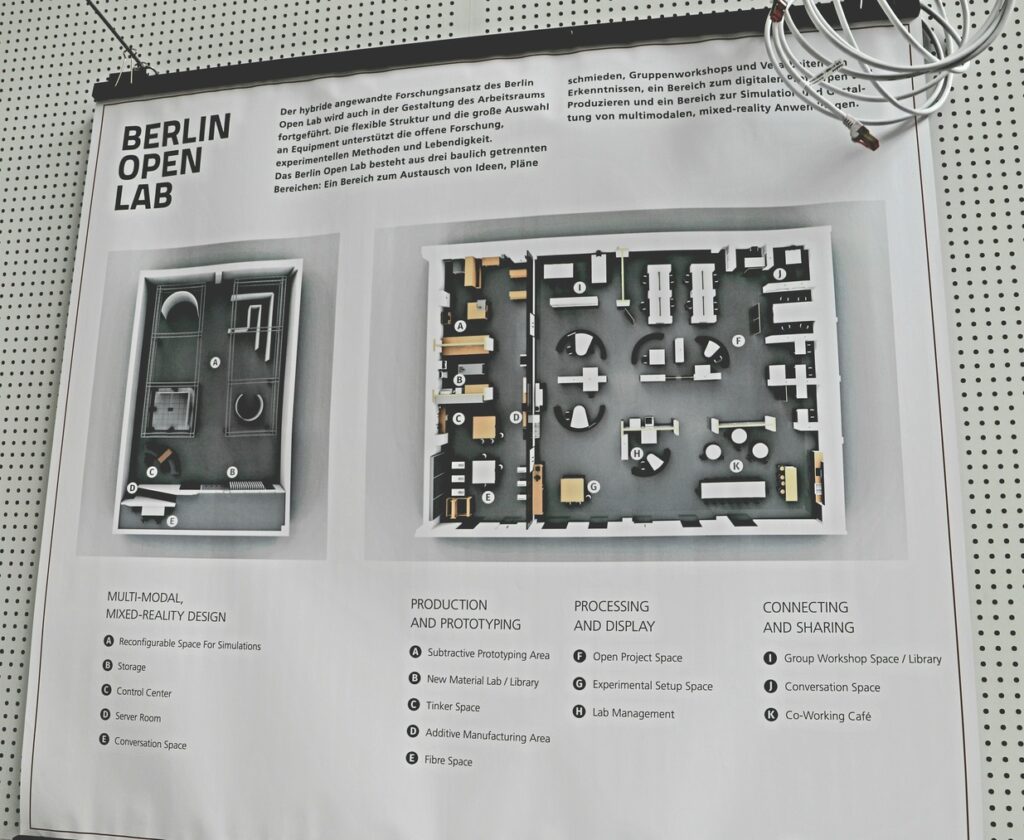
Anna: Can you tell me a bit about the Berlin Open Lab? What is it and how does it function?
Ines: BOL is an experimental space for transdisciplinary research projects at the intersection of technology, society, and arts. It has its own laboratory for digital-based production, smart material interfaces, and wearable computing plus a space for design research with augmented and virtual realities. There is this idea of shared resources and experiences, and flexible and agile working which they try to support with the spatial design of the space. Everything is movable and adaptable here, every group has their space to work in, but it is kind of fluent and changing. So when a new project comes in, you see how you can support them in their working structure, combining it with the spatial aspect. Behind this glass wall is the machine tool area.
And this is the working and event space. I can show you what kind of projects are in here as far as I know, but sometimes it also happens to me that, for example, when the BOL symposium was here, and there were so many projects presented… It’s like oh, I never knew that you are here, but officially, they also have this space.
[laughter]
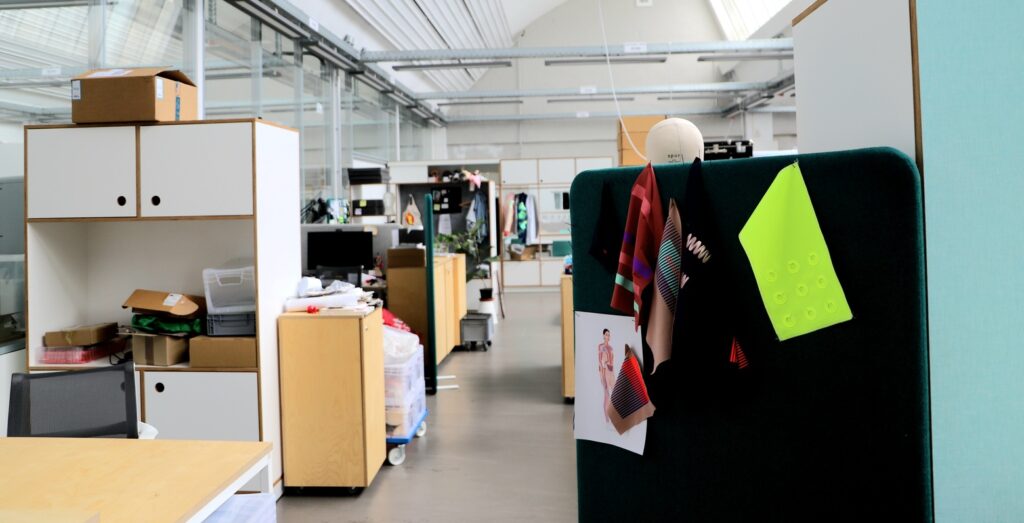
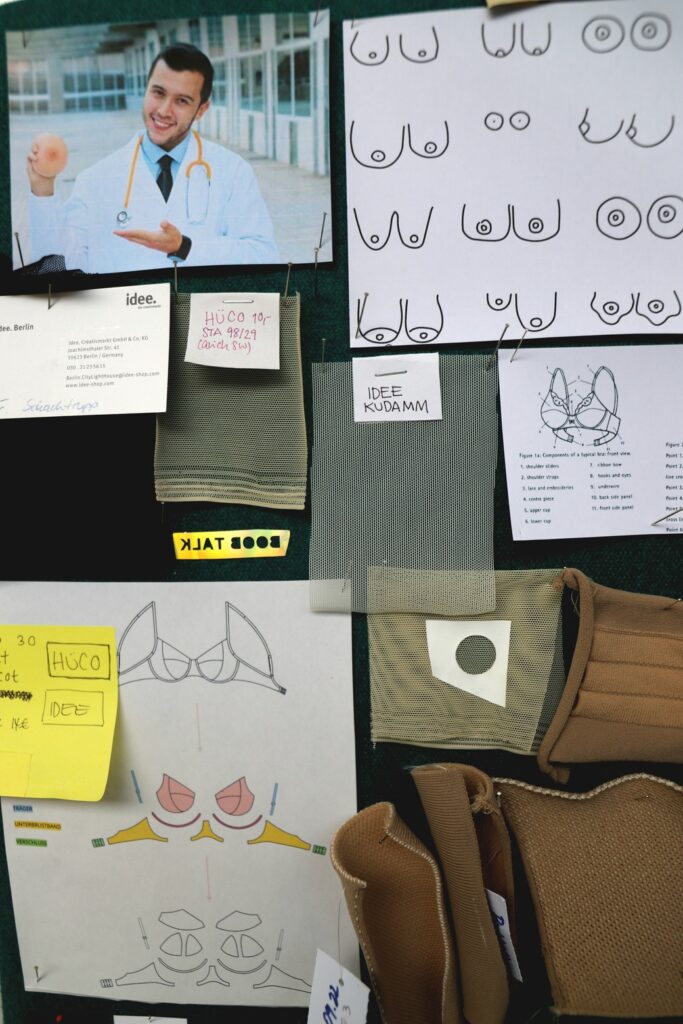
Anna: I sometimes feel like that at the Weizenbaum Institute. There is just so much going on. Is the lab generally open to students who want to use this space?
Ines: There was, for example, this project by a student who was working on her master’s thesis. The project was about breast cancer patients who are losing one or two breasts. Apparently, there are only three shapes or so that you can go for if you are getting an artificial breast, so she tried to develop a process where you can scan the breast and get a prosthesis that is closer to the original shape. She applied for it, and was then able to use the space.
Anna: How many people work here on average on a full day?
Ines: It’s very different. There are maybe fifteen people here on a full day because not everyone is in here all the time. If people need to write, they are not here because it can get too noisy. It is more if they want to use the machines, tools, meet, and work on something together. And if you have silent work, like writing or something…
Corinna: That is why I am not sitting here.
[laughter]
Corinna: Never here…
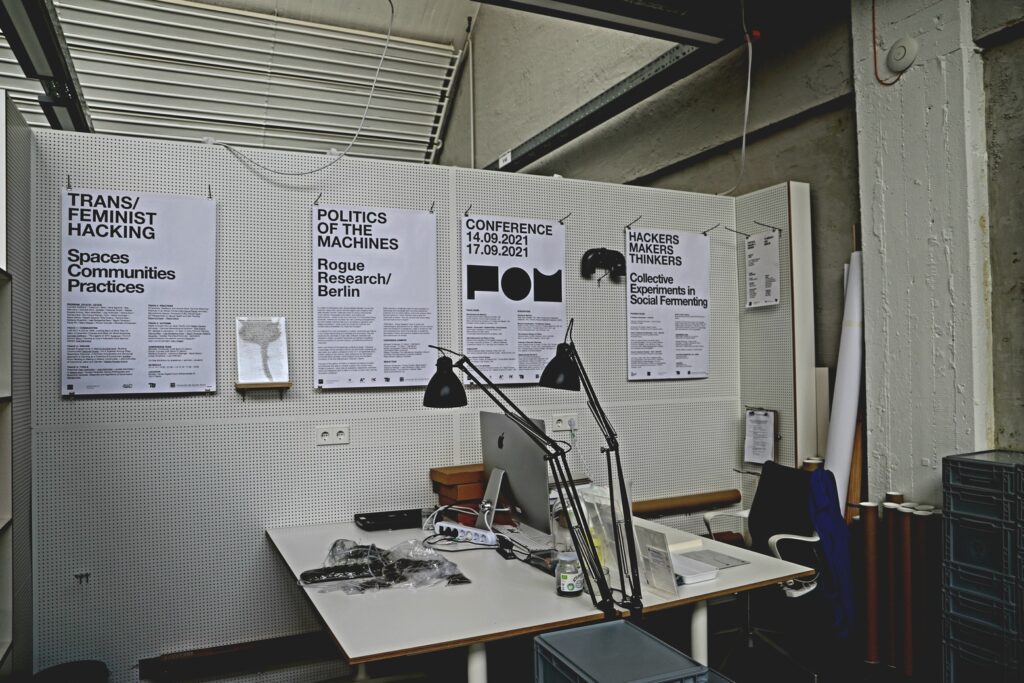

Ines: This is the space from our research group Design Diversity, and New Commons. I am mainly sitting here with Michelle Christensen and Florian Conradi, and our two working students. We use experimental research methods that come out of design, so we are using mainly critical making as a method. This is an approach where you try to combine critical thinking or critical theory—which comes from the humanities—with material production. So the courses we give are always called something like Politics of Machines or Design and Conflict, but they all follow the same structure where students get to know a field of, let’s say, critical theory. It is mainly about technology, but our last course was on the relationship between the environment and humans. The students get a specific perspective with which they look at design and try to use design as a form of critical medium, a tool to bridge this way of critical thinking with material making. The objects that you see here are from different courses that the students had. They build objects or artifacts that are not meant to work in a way so that you can scale them up and bring them to market, but that is more about exploring a way of thinking in materiality. So it is kind of like a critical thought translated into materiality. They are more like curious objects.
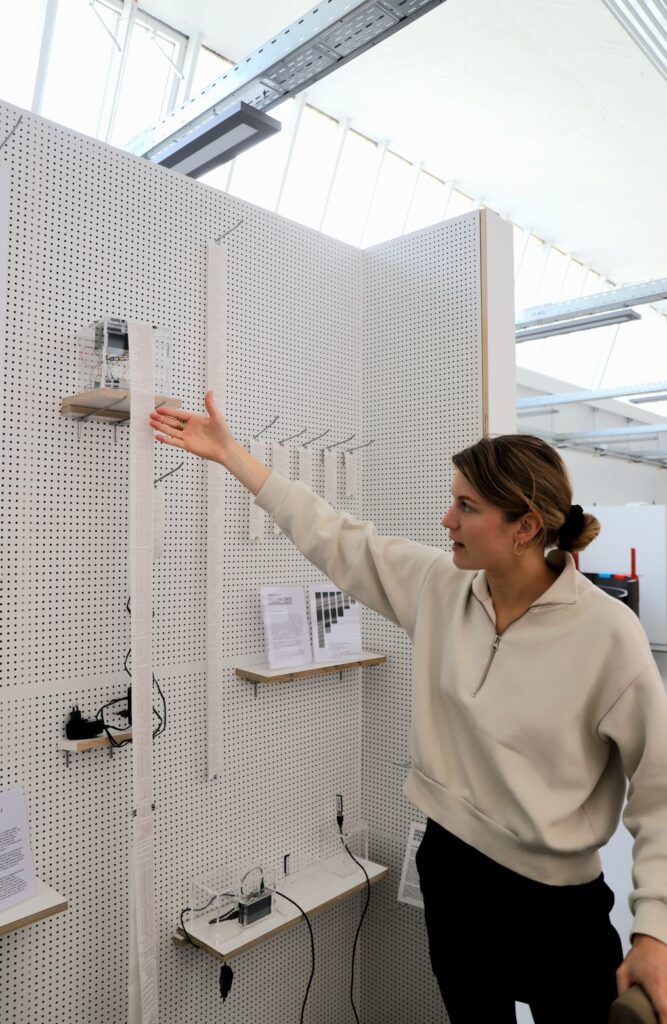
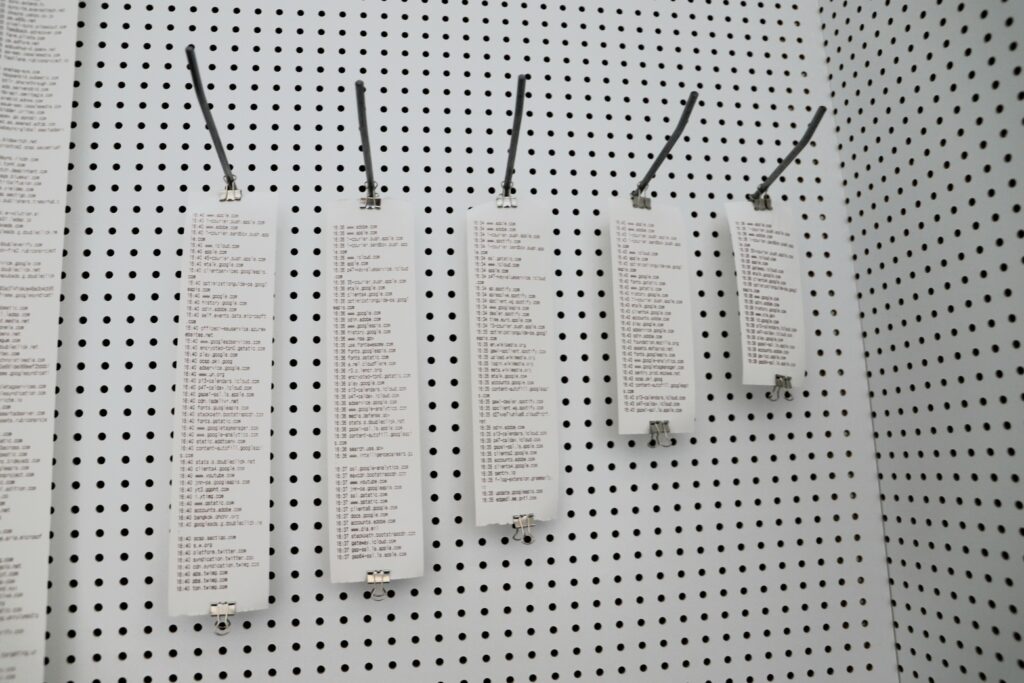
Ines: This was made by a student who looked into surveillance capitalism. He looked into cookies and how much data is constantly saved from you when you are surfing on the internet. As a project, he made this little printer box, where the data of the cookies that the website saved from you is printed in real-time. This, for example, is just 30 seconds of Yahoo!
Anna: Oh, wow.
Ines: And here you can see the different websites and how much data they are saving from you.
Anna: It is interesting to have it printed out like that.
Ines: Yeah. It is interesting because then you can actually see what cookies are. Because if you have a look at it, at some point, you are on a completely different website. And then Spotify turns up and it is like what, this is not the website I am on, but they are checking out everything you do on your computer, what programs you have open. And then you get it. What cookies actually are and what information they are getting from you.
Ines: And this is a project from Pablo. He wanted to find out about how we can get another approach or feeling about what is going on around us in the environment. He installed a CO2 sensor in a box and programmed it in a way so that it gives you a noise signal about how much CO2 is in the air. So you have another approach to what pollution is or how much pollution, or in this case, CO2, is in the air around us.
Anna: So it creates a sound depending on how much CO2 there is?
Ines: Exactly. The more CO2 there is, the more sound there is.
Anna: That is fascinating. And very creative!
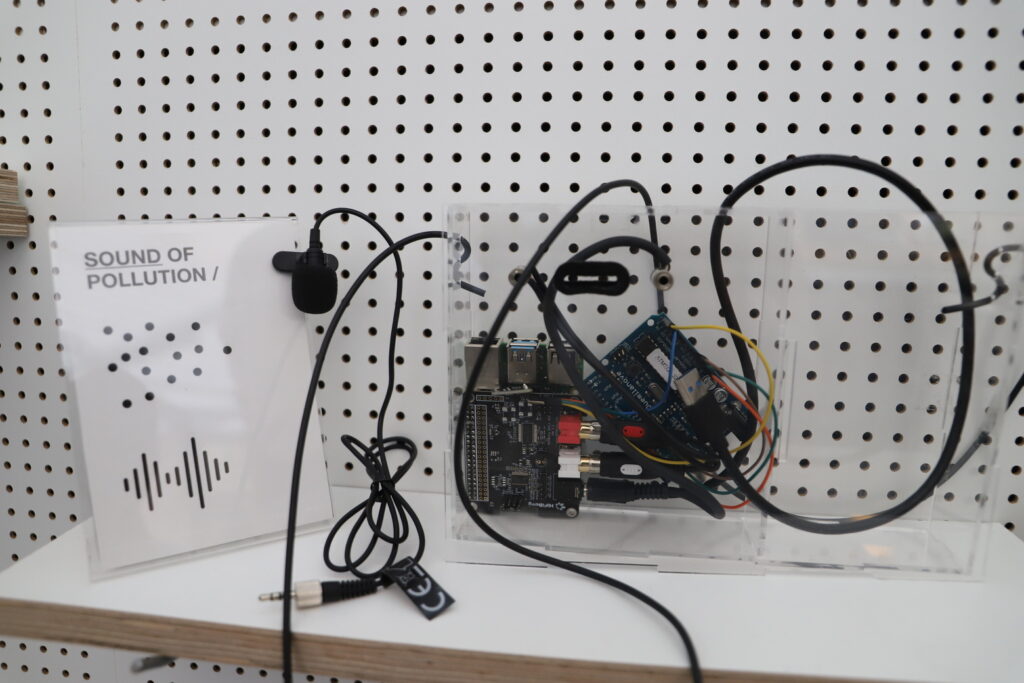
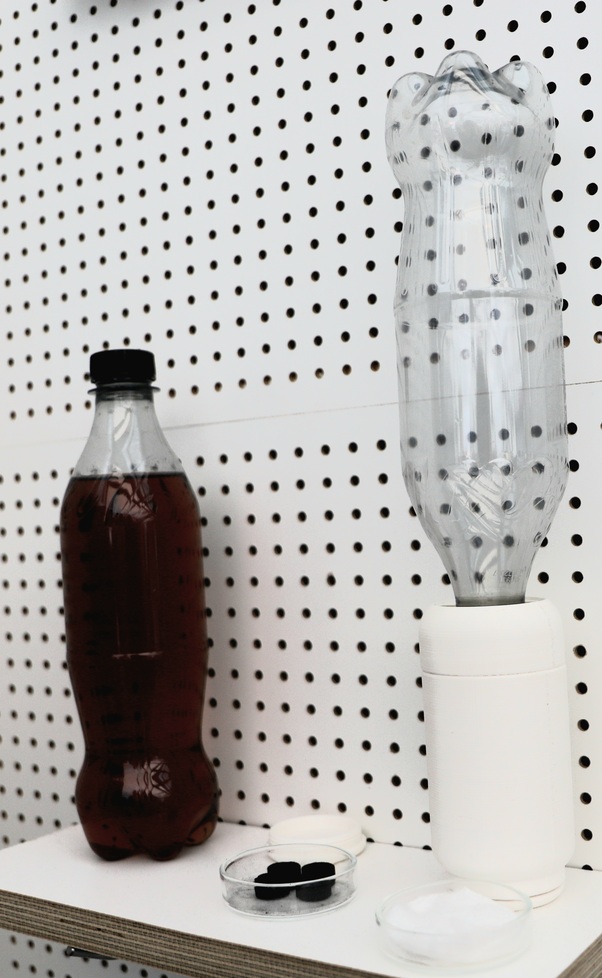
Ines: Yeah. And this is a project where a student was looking into the weird fact that in some parts of the world, it is easier to get Coca-Cola than clean water. The sad story behind it is that clean water is somehow used to produce this Coca-Cola. So she made this as a critical object, a filter that turns Coca-Cola into water, filtering out mainly the sugar and other things, to highlight this weird fact. And that is the sense behind it. To highlight an issue, set up a specific critique, or come up with an alternative way of thinking. While the students are doing prototyping, they learn about technology and the power relations embedded in them, how they function, and how to use them and work with them by building up their own critiques and combining it with practical making. They have to deal with sensors and technology. That is the way they learn to approach this field—by really doing something combined with critical thinking.
Corinna: My part of the research group—that is now just Bianca Herlo and I—we don’t work here and we are not working specifically on design as a tool to make something. We are using design, artistic research, and visual culture research to analyze bias within the digital realm and technology to unpack issues that are mostly unseen. Because like with cookies, they are running in the background, and you need to have tools to visualize them to figure out how they function, how many they are, and how invasive they can be. And this is pretty much the Design Research Lab and what everyone is doing. So this [ground floor] is one part, but then there is the expanded part that mostly sits on the second floor. There are people working in artificial intelligence, in theory per se, in policy-making. It is a broad organism, the Design Research Lab.
Ines: And the BOL is more the practical side of it, a space that was introduced to allow people from a lot of different institutions to use shared tools, machines, knowledge, and open-source libraries. It is not an organization, it is a platform. For us, the main thing is to do research about design methods, and what they can contribute to lacks or errors in current research. Design research methods are often about trying to bridge between different concepts. That is the idea behind it.
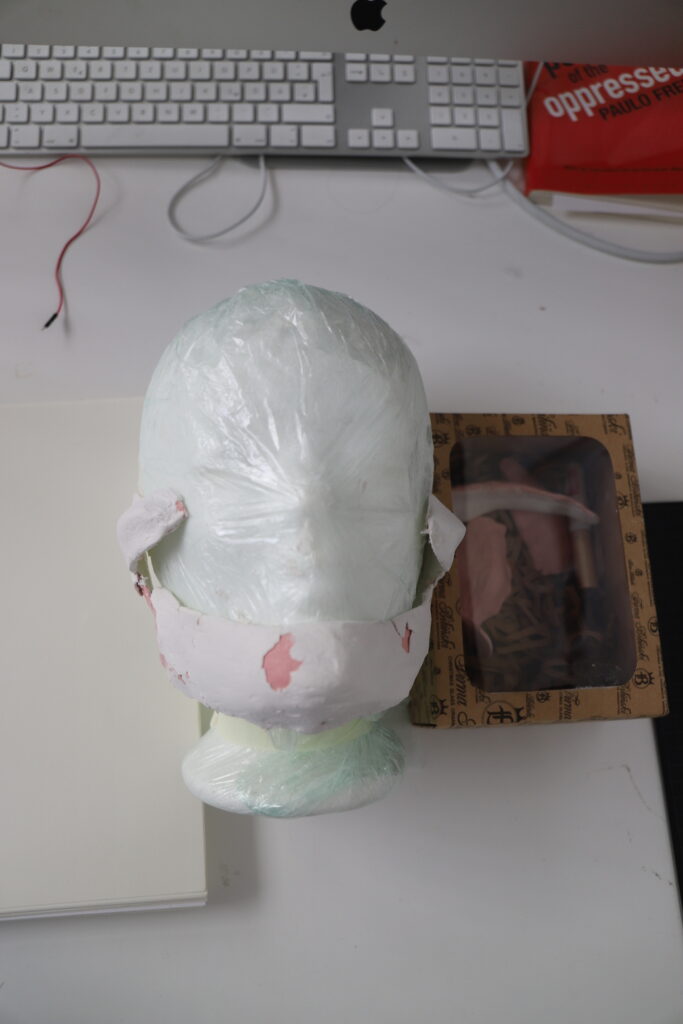
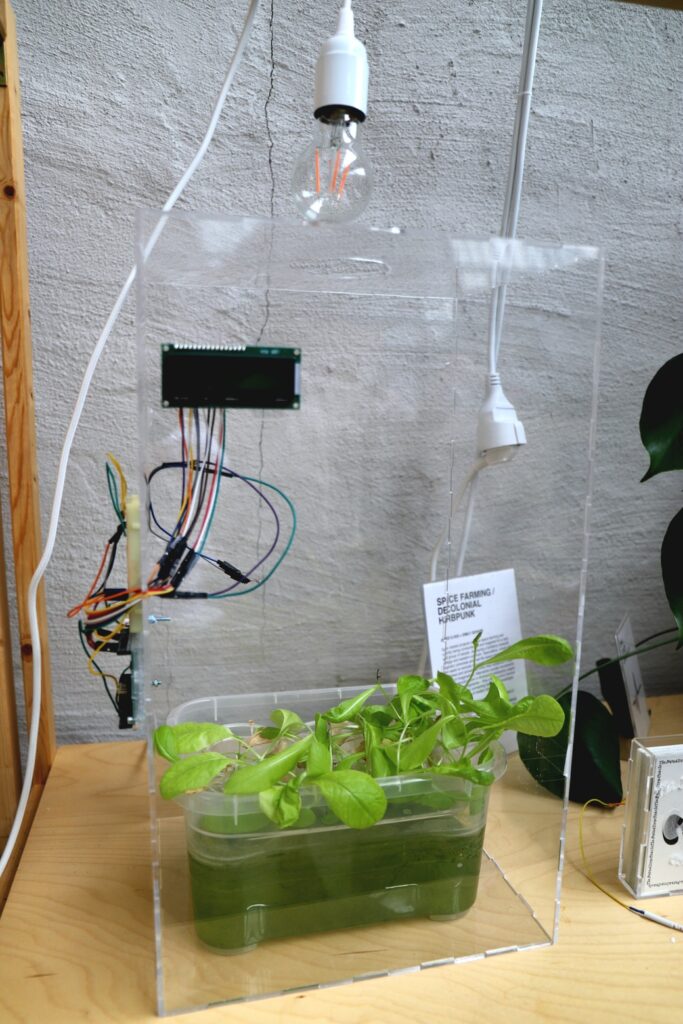
Corinna: The research group is made up of the three of us [refers to student worker Selenay], Athena, and the heads. What we are doing sounds very different from when you actually see the projects that we are working on. Ines and I are both doing our PhDs. I am mostly working on gender bias within internet governance, and Ines is working on practical…
Ines: Practical bridging of the gap between humans and the environment.
Corinna: From the perspective of…
Ines: …the post-humanities.
Corinna: In a way, we found out that we are working on something that has a connection when we did a workshop.
Anna: I was there, yeah, I remember it.
Corinna: The workshop made us realize that there is a common ground. That is, I am working mostly on content moderation, so what gets excluded from the internet and what is allowed. Ines is working on bodily waste and the creation of waste, what the meaning and political significance is of making something into waste and having to throw it out. We are approaching subjects from very different perspectives. I come from visual culture, design, and art, and I am employing analytical methods to analyze image production and consumption online. It is two different ways of experimenting with different kinds of technologies. One is to do more with chemical and biochemical technology. Mine is more digital.
Corinna: Yes, and also moving across disciplines, which is why design research and artistic research have started to grow in the past few years… Because actually they can move across disciplines.
Ines: …and other disciplines struggle with that.
Corinna: Yes, other disciplines are very much constrained within their own boundaries. It is difficult to find people working on artificial intelligence that moves outside of data or computer science. When you are working within design research, it is kind of natural and organic that you grasp from all the disciplines that belong to that, also in some peripheral ways, not just directly. This is kind of what everyone is doing in this space, in a way. It gives you the tools to move across whatever.
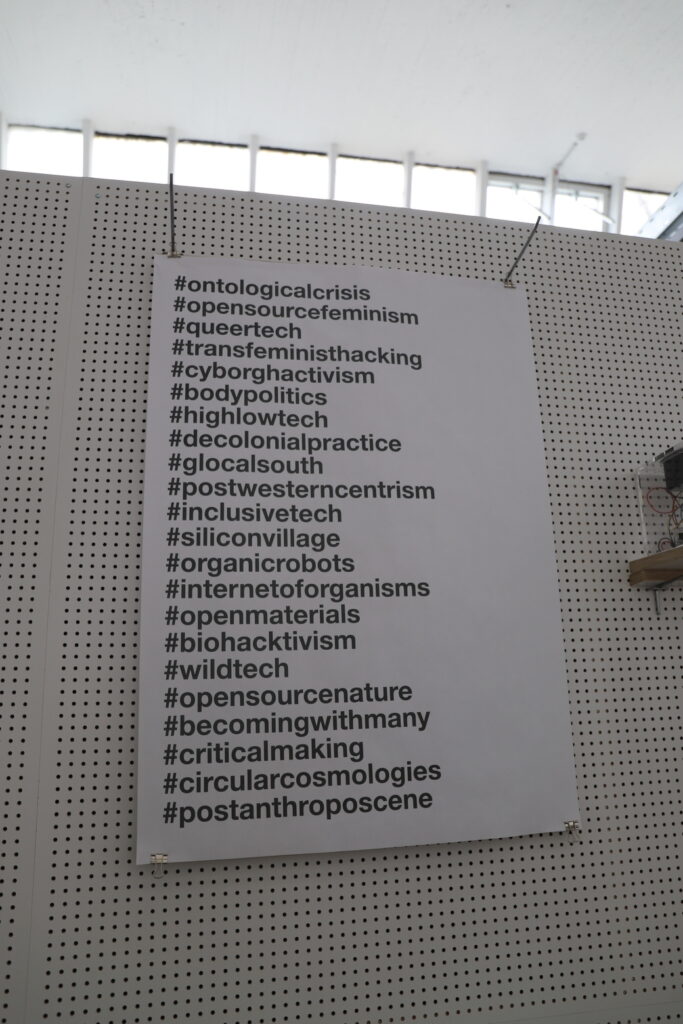
Ines: We are using a process called research through design, so we are actively using the design process itself as an epistemological source. We are designing, and while we are designing we are reflecting on the design process and getting specific knowledge out of it. It is a very practical way of doing research.
Anna: Do you know if there are other labs that have this approach?
Ines: I think there is a whole movement that is trying to implement open labs. I don’t know if they are also doing research. I think that is the special thing here. It is an open, shared lab, but it is also an open shared lab where you are doing research on what is happening. Coming out of the maker movement, there are a lot of areas where people are trying to develop open labs, where you can share machines and access technology like laser cutting and 3D printing.
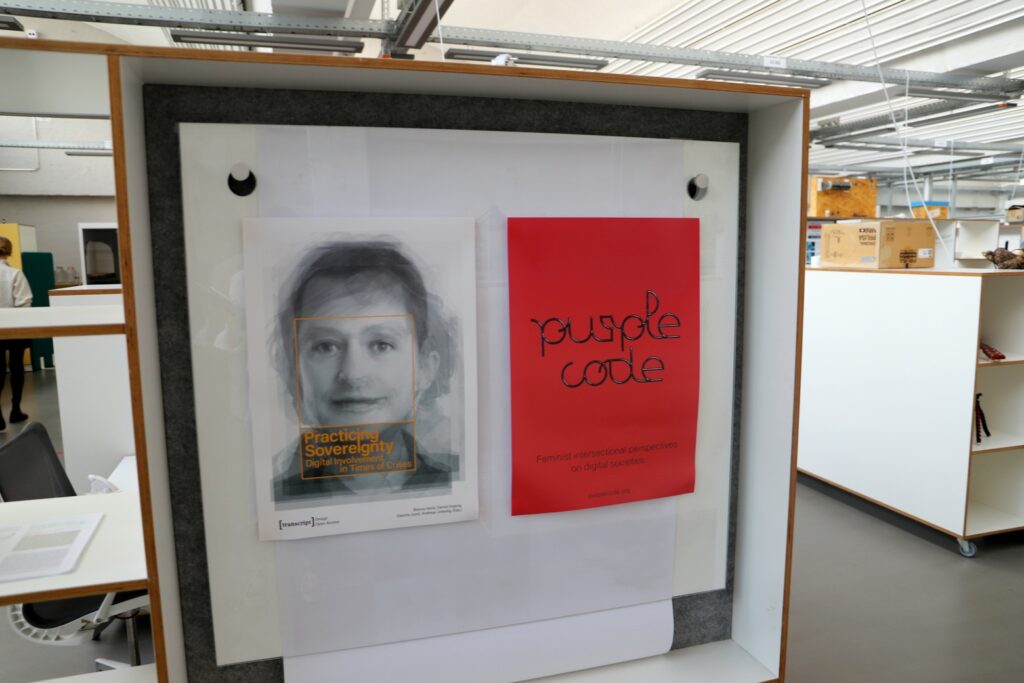
Corinna: There are similar things, but they are mostly focused and financed by industries. So the end goal is not to produce research, but to produce a commodity or something that can be turned into products. The main focus here is research and not producing something that becomes a mass product ready for market. It is to apply a critical, analytical approach to what you are putting out in the world.
Ines: Yeah, there are a lot of labs but not combined with a research focus. We are doing practical making, but also research on practical making through practical making. It is about what value the practical work has in research. There’s a lot of theory also, and for a long time, the material part was missing. Then the material turn came with the idea that we cannot be completely separated from the material world around us… And now they’re trying to find concepts of how to combine those again.
Corinna: At the beginning, it was mostly circumscribed to industrial and product design, and then it kind of started filtering through and moving within the design spectrum as a whole.
Ines: Yeah. And it is still a very young field. I think the whole design research field is still finding itself. It is not like there is one way and everyone is on the same page. There are a lot of different things going on now, people are trying things and having open discussions. It is still an experimental ground.
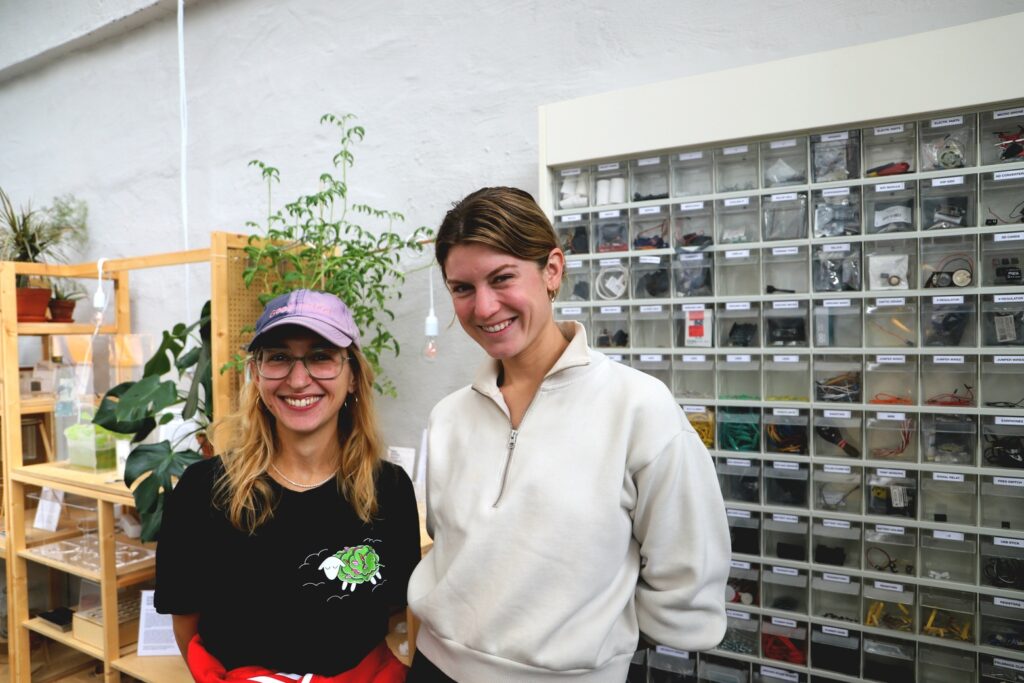
The amalgamation of previously two separate groups, Design, Diversity, and New Commons is part of the Design Research Lab initiative based at the BOL at UdK Berlin. Led by principal investigator Gesche Joost, the group is comprised of research heads Michelle Christensen, Florian Conradi, and Bianca Herlo, research associates Ines Weigand and Corinna Canali, and student assistants Athena Grandis and Selenay Kiray.